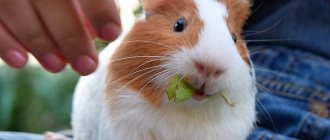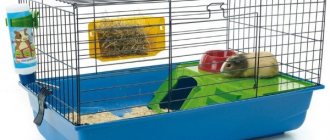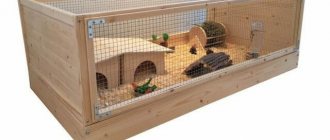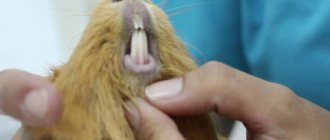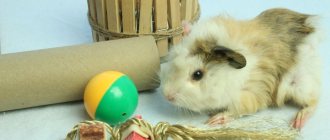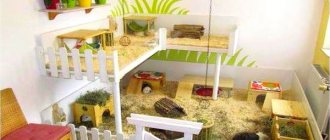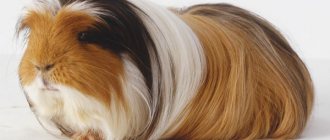Guinea pigs have long been popular pets. These cute rodents are easy to purchase in pet stores or at the Bird Market. However, the animals sold there are often outbred (crossbred) because they do not have any documents confirming their origin. Of course, this will not prevent the pig from becoming a pet, but if you plan to engage in serious breeding of these animals, then such a “breeding breeder” can please you with an unpredictably diverse offspring. For breeding, you should purchase purebred pigs of known origin. Today there are a number of clubs for guinea pig lovers that coordinate the activities of breeders and organize exhibitions. In these clubs you can purchase young animals of different breeds with pedigrees. The choice of breeds is quite large: from the already familiar smooth shorthaired, Peruvian and Abyssinian, to a variety of rare and exotic ones (curly Texels, crested Cresteds, etc.). In general, today there are more than 80 breeds of guinea pigs, differing in the structure, length and color of their coat, and thanks to the work of breeders, more and more new ones are appearing. The most popular marine breeds will be discussed in this article.
There are various classifications of guinea pig breeds in the literature. One of the most common classifications is the division of guinea pigs into three large groups - long-haired, short-haired and rare. Modern breeders also use the following option for dividing into groups:
- English Self - guinea pigs of solid color (solid color)
- Long Hair non Selfs - (Sheltie, Peruvian, Coronet, Texel, Alpaca, Merino)
- Short-haired (woolen) (Coated, non Selfs) - (agouti, American and English Cresteds, Abyssinians, Rexes, etc.).
- Rare Varieties are so-called new breeds that are still quite rare.
The range of colors in guinea pigs is also very diverse; they can be completely monochromatic (white, black, buff, red, chocolate), agoute (natural color), variegated, two or three colors, and even Dalmatians.
What types of guinea pigs are there?
There are several organizations in the world that set standards for rodents. We will focus on the classification Standard for the judging of all cavy breeds as recognized by the European Association of the European Association of Breeders of Poultry, Pigeons, Ornamental Birds, Rabbits and Guinea Pigs.
Pets come in different colors: white, red, cream, black, chocolate and more. There are also spotted individuals. The eyes are black, pink or dark ruby.
Experts divide guinea pig species into three groups based on their coat structure.
Wire-haired guinea pigs
This category includes six species of animal.
- Satin . The rodent's fur is thick and short. Hair shines thanks to its special structure. Their color can be any.
- Crested . The body is covered with smooth and short fur. There is a tuft on the forehead. It is sometimes called a rosette.
- Rex. Rodents have elastic, corrugated fur that stands up straight. The hairs are short and rough to the touch. The mustache is curly.
- Abyssinian. The body is evenly covered with “rosettes”; there can be 10–12 of them. The length of the coat is approximately 3.5 cm.
- American Teddy. The fur is plush and soft. The length of the hairs is at least 2 cm. The belly of young individuals is curly, but this goes away with age. The mustache is straight.
- Swiss Teddy. The wool is rough and crimped. Its length on the body reaches 6 cm. With light contact, the hairs should show elasticity and return to their previous appearance. The mustache is normally wavy.
Abyssinian guinea pig. Photo: Tettania / Shutterstock
Long-haired guinea pigs
There are seven varieties in this category.
- Peruvian. These guinea pigs have very long and soft fur. The bangs completely cover the muzzle.
- Sheltie. The hairs on the animal's head are short. Longer ones start on the cheeks and behind the ears. They grow from the muzzle and form a mane. The fur is silky to the touch.
- Coronet. There is a tuft on the forehead. The hair on the body is long, elastic and soft.
- Alpaca. The rodent has two “rosettes” on its back. The fur is curly. The mustache is normally curly.
- Texel. Long curls on the body. They are directed from the head to the sacrum. The hair on the face is short and crimped.
- Merino. There is a rosette on the animal's forehead. The head is smooth-haired. The longer fur starts behind the ears.
- Lunkaria. The coat is curly and harsh. This makes such a guinea pig look like a sheep. There are two “rosettes” on the sacrum.
Guinea pig coronet. Photo: Pernille Westh/Shutterstock
Smooth-haired guinea pigs
These animals have short and shiny fur. It grows from the head to the back of the body. The length of an individual hair is slightly more than 2 cm. Varieties of rodents differ in color, which are divided into several groups.
- Plain. The body, belly, paws and muzzle of the rodent are covered with fur of the same color.
- Agouti. The animal's fur throughout the body, except the belly, is ticked. This means that each hair has alternating areas of different colors.
- Total agouti. It differs from the previous type only in that there are ticked hairs even on the belly.
- Argent. Guinea pigs with this color also have ticked fur on their bodies. There are no two-color hairs only on the abdomen. The main feature of the variety is dark ruby or pink eyes.
- Labeled . Areas of fur differ from each other in different colors.
Smooth-haired guinea pig with marked color. Photo: Robirensi/Shutterstock
History of the breed
This breed is a real “royal person” among its relatives, and its stunning appearance and always fashionable “hairstyle” have made it very popular among rodent lovers. The history of the appearance of this breed is also very interesting. The Sheltie is the result of artificial selection and the breed dates back to 1938 by crossing Peruvian and American varieties. But the breed finally took shape and received universal recognition only in 1978. After numerous experiments, guinea pigs with magnificent silky strands on the back of various colors were obtained. This breed is certainly one of the most popular at shows.
What is the character of guinea pigs?
A guinea pig bonds with Guinea Pig: Species Profile to a person who takes care of it regularly. Many animals enjoy cuddling with their owners. Some individuals even begin to squeal with excitement when they see loved ones.
Like any pet, a rodent can sometimes get nervous. It rarely bites. If you play with him often, he will get used to it and will feel comfortable in a person's arms.
When exposed to other species, your guinea pig may panic. Special Considerations for Guinea Pigs. Therefore, keep her away from cats, dogs and other animals. This will also help prevent the spread of infections.
Remember: the company of people will never replace the company of animals like themselves. Therefore, it is recommended that Guinea Pig: Species Profile keep pets in pairs.
If you do not intend to breed guinea pigs, consider purchasing two of the same sex. It is believed that females are the best option. Males, especially those who are not castrated, sometimes fight.
Unlike rats and hamsters, guinea pigs are diurnal Special Considerations for Guinea Pigs. Therefore, at night they do not disturb their owners’ sleep.
Ridgeback
Ridgebacks were bred in Sweden in 2004. Their most important external feature is a woolen comb running along the entire length of the back. The color of the hair is varied: from creamy white to ash black. Caring for your pet is incredibly simple: periodically comb out split hairs, introduce vitamin-mineral complexes into the diet during the spring molting period, and visit a veterinarian annually for a routine examination. Ridgebacks are very loyal and sensitive creatures. They do not like to be left alone for a long time, they adore the company of people, and are friendly towards other pets.
Ridgeback
What living conditions do guinea pigs require?
These are active animals, so they need a lot of space. It is best to place the rodent in a spacious cage. How to set up a Guinea Pig cage. The minimum floor area for one individual is 90 × 70 cm, for two - 120 × 70. The height of the home is 45 cm. Then the guinea pig can easily stand on its hind legs.
The bottom of the cage should be hard and smooth, for example plastic. The pet can damage its paws on the slatted floor. The walls of a good house are made of twigs: this ensures normal air circulation.
The How to Set Up the Perfect Guinea Pig Enclosure should not be placed in a draft, near radiators or in direct sunlight. The ideal temperature Special Considerations for Guinea Pigs in the room where rodents live is 18–23 degrees. If it rises above 29 degrees, your pet may suffer from heatstroke. Also try to maintain relatively low air humidity - up to 50%. The area around the cage should be quiet Guinea Pig: Species Profile. Loud noises and sudden movements often cause stress in guinea pigs.
What Do Guinea Pigs Need In Their Cage? nipple drinker. It is also worth buying ceramic bowls. Animals easily turn over plastic dishes.
Photo: Elena Sineglazova / Shutterstock
There should be enough shelters How to set up a Guinea Pig cage in the home so that all the guinea pigs can hide at the same time. Tunnels, houses or pipes will do.
How To Set Up A Guinea Pig Hutch bedding is usually placed on the floor of the hut. You can use paper or fleece. If you want to stick with pellet wood filler, choose aspen. It will absorb the animal's urine well. It is not recommended to buy cedar and pine shavings from Guinea pig housing. When wet, it sometimes releases vapors containing substances that irritate the animal's respiratory tract and paws. Straw won't work either. It can injure your pet's eyes.
general characteristics
Before purchasing an alpaca as a pet, it is important to familiarize yourself with all the characteristics of the animal. The alpaca guinea pig got its name from its long wool, which in its softness and smoothness resembles the wool of cloven-hoofed alpacas.
By their biological nature, these rodents are not natural. Alpaca is a hybrid specially bred by American scientists
The alpaca guinea pig got its name from its long wool, which in its softness and smoothness resembles the wool of cloven-hoofed alpacas. By their biological nature, these rodents are not natural. Alpaca is a hybrid specially bred by American scientists.
In terms of its dimensions, a guinea pig can reach a length of no more than 20 centimeters, and can weigh about 1 kilogram. However, these indicators mostly concern males, and females of the species are usually smaller and lighter.
By itself, it is quite fluffy and thick, reaching a length of 12 centimeters. Moreover, the entire body is covered with wool, including the head (here the alpaca has real bangs).
As for the color of the animal, it can be very diverse (usually multi-colored rather than monochromatic). So, quite often there are combinations of white and black, red, etc.
The lifespan of alpacas varies between 5–8 years. Most often it is at the lower end of this range, but if the animal is healthy and properly cared for, it is possible to extend life by several additional years.
What to feed guinea pigs
Guinea pigs are herbivores. The majority of their daily diet should be Feeding Guinea Pigs hay. A mixture of timothy and oats works best. Alfalfa should be given in small quantities. There is too much calcium in this grass.
If you throw food on the floor of your home, it will mix with the animal's feces. Therefore, some owners buy a hay box that is attached to the bars of the cage.
Photo: jessehr/Depositphotos
It is important that the hay is always fresh Feeding Guinea Pigs. Anything that smells musty should not be given. To prevent it from becoming moldy, you need to choose a storage place. A cool, dry environment is suitable.
You can't do without hay. What should I feed my guinea pigs? . It helps the guinea pig's intestines work properly. The rodent also wears down its teeth, which grow throughout its life.
In addition, vegetables and fruits should be included in the guinea pig's daily diet. This food is a good source of vitamin C. Here are some Feeding Guinea Pigs examples of what you can feed your animal:
- bananas;
- blueberry;
- cantaloupe;
- green peppers;
- strawberry;
- tomatoes;
- watermelon.
There should be more vegetables in a rodent's diet than fruits. All products should first be washed and cut into small pieces. After this, they can be placed in a bowl. If the treat is not eaten within a few hours, it should be thrown away. Rotten food What should I feed my guinea pigs? will only harm the guinea pig.
The animal also needs to be given greens and grass. Lettuce or dandelion leaves, marjoram, arugula, calendula, rosemary, dill, parsley, basil, and carrot tops are suitable.
Guinea pigs can also be fed special granulated food. Make sure the fiber content is at least 16%. But you shouldn’t make the ready-made mixture the basis of your diet.
A rodent should be accustomed to any new foods gradually. Increase the number of treats over two weeks. This will give the digestive system time to adjust and prevent the animal from getting sick.
Some foods seem harmless, but you should not give them to your animal. This is what causes serious What should I feed my guinea pigs? health problems:
- cereals;
- grains;
- nuts;
- seeds;
- dried beans;
- corn;
- buttercups;
- lilies;
- acorns and oak bark;
- avocado;
- rhubarb;
- onion;
- potato tops;
- mushrooms;
- bread;
- cookie;
- chocolate;
- pasta;
- pickled vegetables.
Make sure that the rodent has fresh water around the clock.
Rex
Rex is an officially recognized species of guinea pig, protected by the world organization UNESCO. Distinctive features: unusual short fur of a rigid structure, ears turned inward, long paws with sharp claws, pretty eyes resembling black beads. Rexes are friendly, active and calm, but in some situations they can be stubborn (for example, refusing certain food). Despite the length of the hair, it is recommended to comb it periodically with a special brush. Also follow the correct diet: fresh plant foods (vegetables, grass, greens) should predominate in the diet of these pets. Ready-made food makes up 30% of the main menu.
Rex
How to care for a guinea pig
Unlike dogs and cats, rodents require minimal care. There are several Grooming Care for Your Guinea Pig tips that will help make your pet's life more comfortable.
Trim your nails
The procedure is performed on all guinea pigs. The frequency depends on the rate of claw regrowth. In young individuals with a balanced diet, this happens faster than in older ones. For trimming, you will need special nail clippers; you can buy them at a pet store.
To do everything correctly, look at the claw in the light. You will see a translucent tip, you need to cut it off. Just above the process is the pink part. There are blood vessels there, you can’t touch them. If this does happen, take a paper towel, place it on the wound and press it for a few minutes.
The procedure can be carried out conveniently by two people. One person holds the pet by the stomach and presses it tightly to his body so that the paws do not dangle. The second one cuts his claws. If there is no one to help, the owner can wrap the guinea pig in a towel and hold it under one arm. The fingers remain free.
If the animal is nervous, you should interrupt the procedure and continue later. But most rodents still tolerate having their nails trimmed when they are distracted by food.
Get out of the cage
The pet needs cleanliness. If the home is dirty, the animal may develop How to Clean a Guinea Pig Cage respiratory disease.
Every day, remove those parts of the litter that have already absorbed urine. Then add fresh one. You can use a small spatula.
Once a week, remove shelters, bowls and water bottles from the cage. Treat them with a non-toxic cleaner from a pet store. Wipe down the house itself. Replace all filler with fresh one.
Comb the animal
Rodents with short hair are brushed with Grooming Care for Your Guinea Pig with a soft brush once a week. This keeps shedding to a minimum. Inspect the rodent during the procedure. If you notice ticks, fleas, scratches or scabs, you should contact your veterinarian.
Long-haired pigs are brushed several times a week. This helps avoid tangles. Fine-tooth combs work best for this.
Bathe occasionally
Let's say right away that they bathe the animal only in extreme cases. Grooming Care for Your Guinea Pig. For example, if your guinea pig gets dirty due to diarrhea. In such a situation, the contaminated area should be washed with warm water and animal shampoo. After this, pat the wool dry with a towel.
Crested
Large rodents with short, smooth hair, on the frontal part of which there is a neat miniature crest - this is the Crested breed. Their color can be varied: from fiery red to coal black. They are unpretentious in care and nutrition, lead an active lifestyle mainly at night, and are incredibly sociable and trusting. In the summer, be sure to walk your pet on fresh lawn grass (use a special harness). Crested pigs may have certain problems with their teeth, so a mandatory condition for keeping them is the presence of a mineral stone in the cage.
Crested
What do guinea pigs get sick of?
The condition of the animal must be monitored. Sometimes rodents develop such abnormalities Common Guinea Pig Illnesses.
Diarrhea
It may appear due to a bacterial infection of the intestine or when the animal eats a lot of watery foods. In any case, you need to remove fruits and vegetables from your guinea pig’s diet and add hay. Then the rodent should be taken to the veterinarian.
Dental problems
As we have already said, a rodent's teeth grow throughout its life. If the animal doesn't wear them well, they can become too long. Because of this, some individuals begin to refuse food. Check your guinea pig's mouth every week to help identify problems early. As a preventive measure, you can give your animal chewing sticks from a pet store. In advanced cases, the teeth are trimmed by a veterinarian.
Ticks
Some penetrate the skin and cause irritation. The animal begins to itch. Because of this, the skin turns red and the hair falls out. Recommendations for treatment are given by a veterinarian. Regardless of the remedy that the doctor recommends, the owner must clean the cage. This will help avoid problems in the future.
Respiratory infections
Pneumonia or other illness may occur due to too humid air. The deviation is easy to recognize: the animal wheezes and seems lethargic. These symptoms are a reason to consult a veterinarian as soon as possible.
Scurvy
The animal may lose weight. Sometimes diarrhea and problems with the musculoskeletal system appear. To help the rodent, experts recommend introducing additional foods and vitamin C supplements into the diet.
Cystitis
Females are especially prone to the disease. The abnormality can be noticed by blood in the urine. Sometimes guinea pigs stop urinating completely, so it is important to monitor the litter in the cage.
Self
The Selfie is an Old English breed developed in the 19th century. A uniform uniform coat color, a neat nose with a slight hump, a large head, a dense oval body are the characteristic features by which these pets can be recognized. When you bring a new “resident” into your home, take care in advance of a spacious, comfortable enclosure, provide high-quality meals three times a day, based on 50% vegetables, 30% fruits and 20% cereals. Selfies are incredibly playful and active animals, especially at a young age. Provide them with free access from the cage, giving them the opportunity to run around the apartment 1-2 hours a day, satisfying their natural abilities.
Self
What to look for when buying a guinea pig
The animal can be purchased at a pet store, nursery or from a breeder. Before picking up your pet, check Guinea Pig: Species Profile for the conditions and health of the individual.
Make sure males and females are in separate cages. If they are kept together, you can bring home a pregnant guinea pig.
Observe how the animal you like behaves in the house. Normally he is active and alert. Pick up the rodent and examine it. When everything is good, the fur is clean and without bald spots. There are no redness or scales on the skin. There is no fluid leaking from the ears, eyes, nose or anus. The body is round and strong.
If the animal seems too quiet, refuse the purchase. Your guinea pig may be sick.
Baldwin
Baldwin pigs do not have hair. Their skin has a uniform light beige tint, and in some places it is covered with tiny folds. When purchasing such an animal, keep in mind that its skin is more susceptible to injury and inflammation. Periodically inspect your pet for any abrasions or scratches. If you are going to walk your Baldwin on the street, then choose a place for walking with special care: avoid polluted and dusty areas. These rodents are quite smart, cunning and friendly. When potential danger threatens, they deftly hide in a house or shelter.
Baldwin
Guinea pigs are amazing creatures that are popular among pet lovers. Most of them have a soft, calm, flexible character. Aggression occurs extremely rarely or is completely absent. The average life expectancy is 8-10 years. Provide your pet with quality care, and then he will delight you for many years.
Water treatments
They are necessary in rare cases when the pig is very dirty. The rest of the time she cleans her fur on her own. For water procedures you need to prepare:
- small terry towel;
- special shampoo;
- container with anti-slip coating.
The water temperature should not exceed 38 degrees. During this manipulation, you must carefully ensure that water does not get into the animal’s ears. After completing the bath, he is wrapped in a towel.
Cell
Smooth-haired guinea pigs do not require special care, but they need their own cage, which has an area for eating, resting, playing, and also a toilet. The best design for these purposes is a design with a plastic tray into which a special filler is poured, and dimensions per individual - 80 x 90 cm and a height of about 35-50 cm. Bedding, two feeders, a tray, a drinking bowl, and toys are placed in the cage , stones for sharpening claws, shelves, ladders, and also hay. Pigs feel good at temperatures from 18 to 20 degrees.
Other interesting varieties
The Curly pig's fur is gathered into tousled curls. They look long, but they are not. You won't be able to comb them perfectly. And it's not necessary. The animal looks funny and is pleasant to the touch. The pig is reminiscent of Teddy and Rex in terms of the stiffness and unruliness of its fur. The body length of the Curly reaches 25 cm. The weight of an adult is 1 kg.
The Lunkaria pig is genetically closely related to the Curly breed. Only her fur is longer and more tousled. Another unique breed among guinea pigs is the Kui breed. An adult specimen weighs up to 4 kg. These rodents are bred for fur, meat and fertilizer production.
There are many guinea pigs in nature. Geneticists continue to develop new breeds for exhibitions. In the Russian Federation, some nurseries are engaged in breeding rare species. In ordinary pet stores, only popular short-haired varieties are found. They are easier to keep at home.
Why do hamsters fight?
Discussion: there is 1 comment
- vetpPaype:
10/29/2018 at 10:04 pmAs Antoine de Saint-Exupéry bequeathed, we are responsible for those we have tamed. All our pets provide loyalty, relaxation and joy from communication, but at the same time they represent a great responsibility. Pets require equal attention and good care. Therefore, absolutely any attentive owner always knows where, if necessary, he can buy veterinary drugs for his pet today. Veterinary drugs are not only medicines for diseases, to which, unfortunately, all representatives of the animal world are susceptible. Your beloved pet needs constant care, and above all, the prevention of various diseases. You will need anti-parasite medications, vitamin complexes, eye and ear drops, and vaccinations.
Answer
Cleaning ears and eyes
This is an important step in caring for a smooth-haired guinea pig. Clean them regularly using a regular cotton swab, which must be moistened in an aqueous solution of Chlorhexidine. If there are crusts in the ears, a special “Bars” solution is instilled into them. If the animal squeals when performing this manipulation, then it is advisable to visit a veterinarian, since the cause of this behavior may be ear mites.
Crusts periodically form in the corners of the eyes; they can be easily removed with a cotton pad moistened with warm water or tea leaves. If you notice redness or watery eyes, then most likely a foreign body has entered the eye. In such cases, the help of a veterinarian is required.
Skinny
When talking about what types of pigs there are, it is impossible to ignore hairless animals. Skinny appeared as a result of mutation. But it spread throughout the world only after scientists were able to increase the immune powers of the body of these animals. To maintain a healthy body temperature, skinnies eat a lot.
It has a small fluff on its face and paws, which completes the unusual appearance of the animal.
Those who want to have such a pet need to be prepared for the fact that it requires warmth and a special diet.

